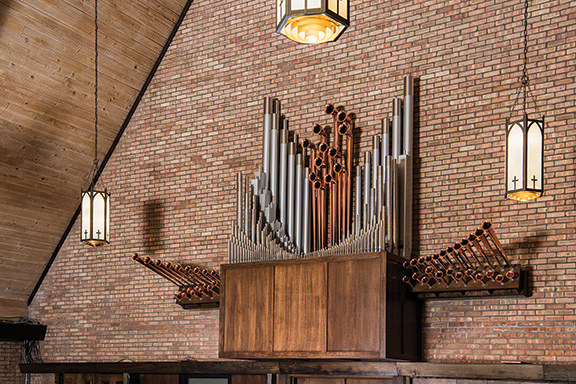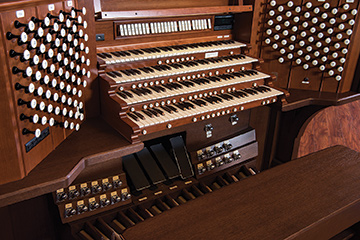 Plainfield United Methodist Church
Plainfield United Methodist Church
Plainfield, Indiana
Reynolds Associates, Inc. Marion, Indiana
By Thad Reynolds
How times change! Plainfield United Methodist Church is a healthy and growing congregation west of Indianapolis. Plainfield has a large choir, and while the music there on any given Sunday morning could be anything from a motet to a Broadway tune, the worship program is usually traditional. Michael Pettry, the church’s organist and music director, makes each Sunday service an event. He does this not by showing off his skill, which is formidable, but by using the instrument to craft a musical environment that supports and enhances worship.

The church’s first pipe organ was a small two-manual instrument with 18 sets of pipes. It had been built by a major builder, and had served the church for more than 40 years. The stoplist was very spare, and the organ was crammed into a small chamber on the right-hand side of the chancel, a space once occupied by the pastor’s office. We had serviced this organ for many years. Over time, it became clear that a serious intervention was needed to preserve Plainfield United Methodist’s long tradition of great organ music. The organ was failing mechanically, and musically it was very limited. This became particularly obvious as the church and its diverse music program grew.
The church formed a committee that included Pettry, Vern Sullenger, Zoe Wiltrout, Les Taber, Paul Schreiner, organ scholar Jaime Carini, the Rev. Charlie Wilfong, pastor, and former pastor Ted Blosser. Together, they explored all the possibilities that were open to them. They listened to electronic organs and pipe organs, large and small. They considered rebuilding and expanding the old organ. For a few weeks, they even had a vintage Hammond B3 in the chancel!
The church needed an organ with variety, musical flexibility, color, and power. The new organ needed to fit within a sensible budget and limited footprint. Although they visited electronic organ installations, the committee members could clearly “tell the difference.” We were delighted and honored when they selected our firm for their big project. One other important early decision was to engage concert organist Martin Ellis to consult on the initial design. He made several key contributions to the tonal design and outfitting of the instrument.
The church’s vision was to have a pipe organ that could be used in concert and for study, as well as for Sunday worship, and one that would make a striking visual statement in their worship space. No church has unlimited funds, but by far the most limiting factor in Plainfield’s design was the amount of space that would be available. We began discussing a three- or four-manual organ in a chancel area that was already overcrowded on many Sundays. We felt that the organ, whatever its size, needed complete ensembles in all divisions, with plenty of color in the strings, flutes, and reeds. The organ committee was not averse to exploring some digital augmentation to fill out the specification in the space available, and was intrigued by the idea of incorporating some appropriate vintage pipe sounds into their new organ.

Working with our partners at Organ Supply Industries, we developed a visual concept that emphasized deep wood tones in the rift-sawn oak case, and the verticality of the 16′ Contrabass pipes to create a stunning effect that draws the eye upward to the cross, in its high central position. The main case is divided into four sections. The Swell is divided between the left wing of the case, which contains the Swell ensemble stops, and a lower position in the center, behind the choir seating. The lower Swell contains stops that are likely to be used for accompaniment. Their position makes them easy for the choir to hear, and provides a perfect balance and blend between organ and singers. The Choir division is in the right wing. The Great is elevated in the center. We also created an unenclosed Antiphonal division that is mounted on the rear wall of the sanctuary. Its main purpose is to help support congregational singing. Its tonal design, scaling, and voicing are more typical of a small Great than of an Echo. David Reynolds’s design places the flue pipes in a standard V diatonic layout, with the copper Trompette en chamade above 4′ C mounted horizontally to either side of the chest. The twelve longest pipes are hooded in the center of the chest, looking much like a stand of sunflowers on the back wall of the church.
The new organ in Plainfield is a celebration of old and new. Its complement of voices includes about 50% new pipework, along with pipes revoiced from the old organ and several vintage ranks by Estey, Skinner, and Austin. The organ has four trumpets. Two of these, the Swell 8′ Trumpet and the 8′ Trompette en chamade, were built for us by Oyster Pipeworks, another of our important industry partners. The main 8′ Trumpet is in the upper Swell; the Skinner 8′ English Trumpet is in the Choir, in the opposite wing. Although these voices are of nearly the same intensity, the new reed is brighter, while the Skinner reed has a warmer sound, almost that of a Tromba. Played together, they balance the Trompette en chamade in the Antiphonal division. This fanfare trumpet is constructed of polished copper with beautifully flared bells. It is voiced to stand out but not overwhelm the instrument. Powerful fanfare reeds are indeed thrilling, but they are often limited to those festival occasions when the organist is willing to risk losing his job by using them.
The use of digital voices in a pipe organ remains controversial among organbuilders. While we do not use them in all our organs, we feel that they can contribute to tonal flexibility if used properly. In this case, they allowed us to include tonal components that would have been otherwise impossible because of the tight space. Primarily, the digital voices in this organ are stops that “stand behind” other sonorities, such as a digital celeste that is paired with a string of real pipes. In this organ, we also included digital voices in the Pedal: a 16´string and 16′ and 32′ Trombone. Much of the flexibility of this organ can be attributed to the Peterson ICS4000 integrated control system, which we use exclusively in our projects.

The new organ at Plainfield United Methodist Church integrates successfully into the chancel of the church building, with room for choir risers, seating, lectern, communion table, and a concert grand piano. It actually takes up only slightly more space than the previous organ, partly because of the use of cantilevers, and partly because of wasted space that was reclaimed in the new design.
We are grateful to the congregation of PUMC, their organ committee, and their organist for their patience and support. We particularly want to thank Vern Sullenger, who volunteered to work alongside us nearly every day. If Vern ever decides to come out of retirement, he would make a great organbuilder. The congregation first heard their new organ in church in July 2016. After that inaugural service, I noticed that many in attendance came to the front of the church around the case and console. Suddenly, I realized why. They were taking “selfies” with their new pipe organ!
For most of the hundreds of years that organbuilders have been building organs, the business has been a cottage industry of small shops building individual instruments for individual customers. This all changed for a time starting in the latter half of the 19th century when builders like the Hooks began mass-producing pipe organs on a large scale. The zenith of industrial organ manufacturing was reached in the 1920s when M.P. Möller was producing an organ each day.
In the years since, organbuilding has returned to being the cottage business it once was. Most American builders today focus on the individual customer. The result is that the industry is now crafting finer instruments than ever before.
An important key to the industry’s success is the group of suppliers, vendors, and specialty shops that cater to the organbuilder. Many components in a pipe organ benefit from industrial production. Most importantly, these companies give us the ability to focus on the instruments themselves—their layout, tonal design, and the all-important voicing and finishing. Our firm designs and manufactures windchests, reservoirs, and other major components. We also rebuild and recondition pipes and blowers. We do our own design work, installation, and finishing. We maintain many organs for churches across the area. We rely on our suppliers to provide us with quality components for our instruments.
We are proud of the contributions of Organ Supply Industries, Peterson Electromusical Products, and Oyster Pipeworks to the Plainfield organ. We embrace the expertise of these fine craftsmen and women, and are delighted to include them as Reynolds “Associates.” We thank each of them for their magnificent work on this organ.
Project Contributors
Thad Reynolds
David Reynolds
Cory Kline
Robert Rouch
Jonathan Farnsley
Photography: Chris Whonsetler (Whonphoto.com)
Thad Reynolds, president and tonal director of Reynolds Associates Inc., is a member of the American Institute of Organbuilders, the American Guild of Organists, and the Organ Historical Society. He has participated in many workshops and masterclasses on virtually all aspects of the art and business of organbuilding, and has also sponsored and provided workshops for his clients. For more information on Reynolds Associates, including a complete stoplist of this organ, visit Reynoldsorgans.com.
From the Director of Music:
Sometimes life is about the destination, while at other times it’s more about the journey. In the case of this pipe organ project, our initial focus on the final destination—that of a new pipe organ —led us on a journey that strengthened this congregation in ways seemingly unanticipated. In essence, the Plainfield United Methodist Church congregation gained not only a new pipe organ but also a more vibrant appreciation for the role of music in worship, and a greater sense of charitable ability and gratitude.
A church of over 1,100 members, PUMC has a long tradition of supporting music in worship and yet we had need for a strategic, three-year advocacy plan to “make the case” for moving forward with this project. Elements of the strategy included two weeks of a “pipe organ petting zoo” in the narthex for people to touch, see, and even make the pipes sound with their own lungs; a large, visual timeline of various events including music history, religion, world events, and pipe organ evolution displayed throughout the church building; and a conscious decision to more frequently have members of the congregation play the postlude, allowing the organist time in the narthex between our three services to advocate and provide answers to questions.
The PUMC congregation raised all the funds to support the project through cash donations in a 15-month period. Although a congregation of respectable financial ability, this marked the largest “successful” fundraising campaign ever by this congregation in its 150-plus years of existence.
We employed best practices from professional fund-raisers including gift range charts, constituency models, and peer solicitation. We created a clear plastic fund-raising thermometer in the narthex that we filled with Hershey’s Kisses as funds were contributed. This campaign not only raised the needed money, but also established a deeper understanding of gratitude—and how to genuinely show it—for the congregation.
The artistic visionaries from Reynolds Associates provided this congregation with one of the most rewarding instruments to play as a musician and to experience as a worshiper. The builders’ understanding of the duality of a pipe organ’s function as a tool for leading worship and concertizing alike will serve today’s congregation and future generations with aplomb.
Michael Pettry
View the Stoplist in the OHS Pipe Organ Database
Hear this organ on YouTube:
No stop list? How much is digital?
Boyd,
A stoplist from the Organ Historical Society database is now available at the bottom of the post.